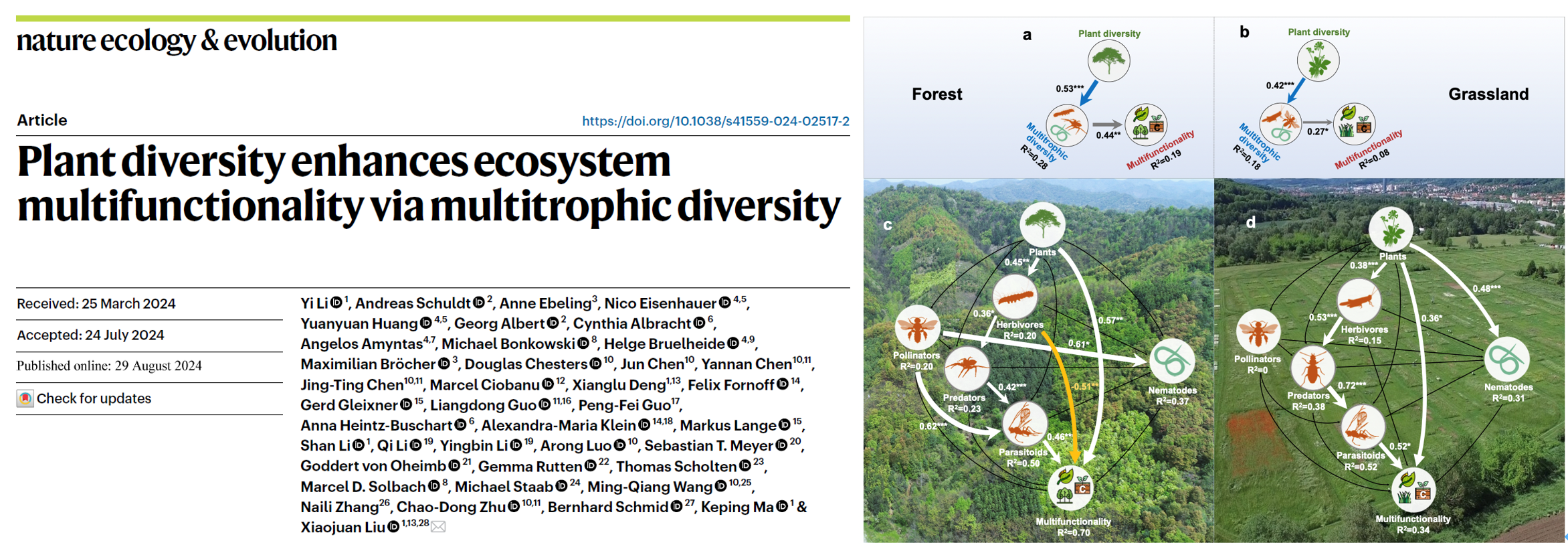An international research team led by Prof. Xiaojuan Liu from the Institute of Botany at the Chinese Academy of Sciences (IBCAS) has shown that, in both forest and grassland ecosystems, the association between multitrophic diversity and multifunctionality was stronger than the relationship between the diversity of individual trophic groups and multifunctionality.
The researchers show that plant diversity increases multifunctionality through elevated multitrophic diversity.
The results have recently been published in the journal Nature Ecology & Evolution.
The findings imply that, to promote ecosystem multifunctionality, conservation planning must consider the diversity of both plants and higher trophic levels.
Using data from two large biodiversity experiments, one representing subtropical forests (BEF-China) and the other temperate grasslands (the Jena Experiment) the results expand previous findings on the relationship between plant diversity and different ecosystem functions, including plant diversity and multifunctionality relationships.
The study also reveals that the relationship between multitrophic diversity and multifunctionality is stronger than diversity effects of any individual trophic group, including plants and that the role of multitrophic diversity is greater in forests than in grasslands.
Dr. Yi Li, the first author, explains that trees, with their longer life cycles and greater structural complexity compared to herbaceous plants, support higher multitrophic diversity and more complex trophic interactions.
As Prof. Xiaojuan Liu, the management group leader of the BEF-China experiment platform and the last author explains, this study provides the first comprehensive experimental evidence that plant diversity enhances ecosystem multifunctionality via multidiversity in different types of ecosystems.
Overall, although differences in the food web structure among ecosystems can lead to variability in specific relationships between diversity and functionality, this is leveled out when multidiversity is high.
As Prof. Keping Ma, the chair of the BEF-China experiment platform said, this study contributes to strengthening public understanding of multidiversity conservation, including the diversity of both plants and higher trophic levels such as arthropods or soil nematodes.
Prof. Dr. Nico Eisenhauer, the speaker of the Jena Experiment, highlights that the combination of results from such distinct ecosystem types in different biomes is extremely novel and valuable to describe the general relevance of biodiversity. Comprehensive long-term data on above- and belowground food webs are key to understand the ecosystem consequences of biodiversity loss.
As the study shows, ecosystems can sustain many important functions, but only when diversity is high. Thus, it is important to preserve and manage all ecosystems to the benefit of species and mankind.

Figure 1. Study sites, vegetation structure, and example arthropods of the BEF-China and Jena biodiversity experiments

Figure 2. Relationships between multitrophic diversity (or diversity of individual trophic groups) and multifunctionality (or individual functions).

Figure 3. Plant diversity enhancing multifunctionality through multitrophic diversity or the diversity of multiple trophic groups.
Literature:
Yi Li, Andreas Schuldt, Anne Ebeling, Nico Eisenhauer, Yuanyuan Huang, Georg Albert, Cynthia Albracht, Angelos Amyntas, Michael Bonkowski, Helge Bruelheide, Maximilian Bröcher, Douglas Chesters, Jun Chen, Yannan Chen, Jing-Ting Chen, Marcel Ciobanu, Xianglu Deng, Felix Fornoff, Gerd Gleixner, Liangdong Guo, Peng-Fei Guo, Anna Heintz-Buschart, Alexandra-Maria Klein, Markus Lange, Shan Li, Qi Li, Yingbin Li, Arong Luo, Sebastian T. Meyer, Goddert von Oheimb, Gemma Rutten, Thomas Scholten, Marcel D. Solbach, Michael Staab, Ming-Qiang Wang, Naili Zhang, Chao-Dong Zhu, Bernhard Schmid, Keping Ma, Xiaojuan Liu*. 2024. Plant diversity enhances ecosystem multifunctionality via multitrophic diversity. Nature Ecology & Evolution. 8: 2037–2047. https://www.nature.com/articles/s41559-024-02517-2.

